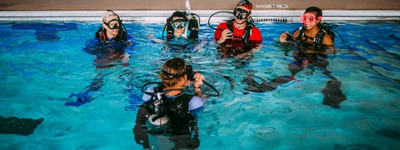
If you’re looking for a scuba diving experience that combines fossil hunting, mystery, and the thrill of discovery, hunting for megalodon teeth is a bucket-list-worthy adventure. Nothing compares to the moment you uncover a 4-million-year-old tooth buried beneath layers of sediment.
After several highly successful dive trips to hunt for teeth in South Carolina, Dive Pro Drago has developed expert-level knowledge on how to increase your chances of bringing home prehistoric treasures—and now, he’s sharing his top tips.
A Brief Bite of Megalodon History
Megalodon (Otodus megalodon) was the largest shark to ever live, swimming Earth’s oceans roughly 23 to 3.6 million years ago. These ancient predators could reach up to 60 feet in length, and their teeth—often measuring more than six inches—are among the most sought-after fossils by divers. Each one is a rare and awe-inspiring reminder of a time when these giants ruled the seas.

Buoyancy Is Everything
Tooth hunting often happens in shallow areas with shifting currents and soft sediment. You’ll want to be slightly over-weighted to stay low and steady while you search—but not so heavy that you burn through your air dragging yourself along the bottom. The goal is control, not struggle. Get your buoyancy dialed in, and your whole dive becomes more efficient.
Prepare for Low Visibility
Megalodon teeth are rarely found in crystal-clear water. Conditions are typically murky, and visibility can drop to zero if the bottom gets stirred up. A good diver learns to stay calm and rely on touch and technique. If you can’t tell which way is up, watch your bubbles—they always know.


Look for Triangles
Megalodon teeth—and most shark teeth—are triangular. You’ll come across other bones and fossils—vertebrae, rib fragments, shells—but stay focused on the shape. Scan methodically, and over time your eye will naturally catch those sharp, pointy edges buried in the mix.
Keep It Moving (at First)
If you’re not seeing any dark fossil material, don’t waste time. Keep moving until you spot black rock or gravel, or stumble onto an area that feels fossil-rich. This hunt is part intuition and part perseverance.
Slow Down When You Find Teeth
The moment you find your first tooth—or even just a piece of one—pause. Fossils tend to collect in clusters, and one find often means there are more nearby. Don’t rush through a good spot. Take your time and comb it carefully.

Remember: You’re Holding History
Every tooth you find has been buried for millions of years, untouched by human hands. That alone makes it priceless. Whether it’s a half-inch fragment or a full 6-inch monster, the moment you discover it is unforgettable—and completely yours.
Prepare for the Hunt
Megalodon tooth dives often take place in challenging environments. Preparation is key to making the most of your time underwater and increasing your chances of uncovering prehistoric treasures. Before heading out, consider sharpening your dive skills to boost your confidence and effectiveness on the hunt. These specialty courses are available at Diventures and are the perfect way to gear up for your next epic dive:
- Perfect Buoyancy
- Navigation
- Night & Limited Visibility
Ready to Dive Into the Past?
Whether you’re planning your first fossil dive or already have a few ancient treasures in your collection, there’s always more to discover. And if you’re dreaming about digging for teeth alongside Drago himself, stay tuned—we’ve got more fossil-hunting trips to South Carolina coming this spring. Keep an eye on our website and social channels for updates.















